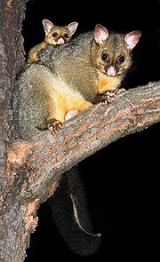
Common Brushtail Possum
Overview
The Common Brushtail Possum (Trichosurus vulpecula, from the Greek
for "furry tailed" and the Latin
for "little fox", also known as Phalangista vulpina) is a nocturnal, semi-arboreal marsupial
of the family Phalangeridae
, it is native to Australia
, and the largest of the possum
s.
Like most possums, the Common Brushtail is nocturnal. It is mainly a folivore
, but has been known to eat small mammals such as rats.
Ancient Greek
Ancient Greek is the stage of the Greek language in the periods spanning the times c. 9th–6th centuries BC, , c. 5th–4th centuries BC , and the c. 3rd century BC – 6th century AD of ancient Greece and the ancient world; being predated in the 2nd millennium BC by Mycenaean Greek...
for "furry tailed" and the Latin
Latin
Latin is an Italic language originally spoken in Latium and Ancient Rome. It, along with most European languages, is a descendant of the ancient Proto-Indo-European language. Although it is considered a dead language, a number of scholars and members of the Christian clergy speak it fluently, and...
for "little fox", also known as Phalangista vulpina) is a nocturnal, semi-arboreal marsupial
Marsupial
Marsupials are an infraclass of mammals, characterized by giving birth to relatively undeveloped young. Close to 70% of the 334 extant species occur in Australia, New Guinea, and nearby islands, with the remaining 100 found in the Americas, primarily in South America, but with thirteen in Central...
of the family Phalangeridae
Phalangeridae
Phalangeridae is a family of nocturnal marsupials native to Australia and New Guinea, including the cuscuses, brushtail possums, and their close relatives...
, it is native to Australia
Australia
Australia , officially the Commonwealth of Australia, is a country in the Southern Hemisphere comprising the mainland of the Australian continent, the island of Tasmania, and numerous smaller islands in the Indian and Pacific Oceans. It is the world's sixth-largest country by total area...
, and the largest of the possum
Possum
A possum is any of about 70 small to medium-sized arboreal marsupial species native to Australia, New Guinea, and Sulawesi .Possums are quadrupedal diprotodont marsupials with long tails...
s.
Like most possums, the Common Brushtail is nocturnal. It is mainly a folivore
Folivore
In zoology, a folivore is a herbivore that specializes in eating leaves. Mature leaves contain a high proportion of hard-to-digest cellulose, less energy than other types of foods, and often toxic compounds. For this reason folivorous animals tend to have long digestive tracts and slow metabolisms....
, but has been known to eat small mammals such as rats.
Unanswered Questions

